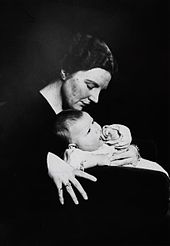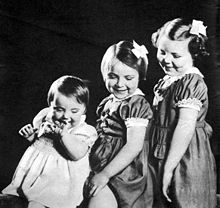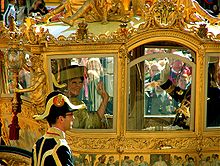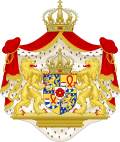- Beatrix of the Netherlands
-
Beatrix 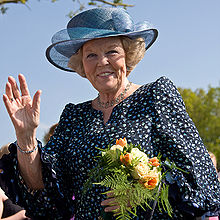
Queen Beatrix in 2008 Queen of the Netherlands Reign 30 April 1980 – present Predecessor Juliana Heir apparent Willem-Alexander, Prince of Orange Prime Ministers See list Spouse Claus von Amsberg
m. 1966–2002 (his death)Issue Willem-Alexander, Prince of Orange
Prince Friso
Prince ConstantijnFull name Beatrix Wilhelmina Armgard House House of Orange-Nassau Father Bernhard of Lippe-Biesterfeld Mother Juliana of the Netherlands Born 31 January 1938
Baarn, NetherlandsSignature 
Religion Christian (Protestant Church in the Netherlands) Beatrix (Beatrix Wilhelmina Armgard; born 31 January 1938) is the Queen regnant of the Kingdom of the Netherlands comprising the Netherlands, Curaçao, Sint Maarten, and Aruba. She is the first daughter of Queen Juliana of the Netherlands and Prince Bernhard of Lippe-Biesterfeld. She studied law at Leiden University. In 1966, she married Claus von Amsberg, with whom she had three children: Prince Willem-Alexander (born 1967), Prince Friso (born 1968), and Prince Constantijn (born 1969). When her mother Juliana abdicated on 30 April 1980, Beatrix succeeded her as Queen of the Netherlands. On 6 October 2002 Prince Claus of the Netherlands died.
Contents
Early life
Princess Beatrix was born Princess Beatrix Wilhelmina Armgard of the Netherlands, Princess of Orange-Nassau, Princess of Lippe-Biesterfeld on 31 January 1938 at the Soestdijk Palace in Baarn, Netherlands. She was the eldest daughter of Crown Princess Juliana of the Netherlands and Prince Bernhard of Lippe-Biesterfeld.[1] Beatrix's five godparents are King Leopold III of the Belgians, Princess Alice, Countess of Athlone, Princess Elisabeth of Waldeck and Pyrmont, Duke Adolf Friedrich of Mecklenburg, and Countess Allene de Kotzebue.[2] When Beatrix was one year old, in 1939, her first sister Princess Irene was born.[1]
When World War II broke out in the Netherlands in May 1940, the Dutch Royal Family fled to London, United Kingdom. One month later, Beatrix went to Ottawa, Ontario, Canada with her mother Juliana and her sister Irene, while her father Bernhard and maternal grandmother Queen Wilhelmina remained in London.[1] The family lived at the Stornoway residence.[3] In thanks for the protection of her and her daughters, (then) Princess Juliana established the delivery of tulips to the Canadian government every spring, which are the centrepiece of the Canadian Tulip Festival. Her second sister Princess Margriet was born in 1943.[1] During their exile in Canada, Beatrix attended nursery and the primary school[4] Rockcliffe Park Public School.[5]
The family returned to the Netherlands on 2 August 1945. Beatrix went to the progressive primary school De Werkplaats in Bilthoven. Her third sister Princess Christina was born in 1947.[1] On 6 September 1948, her mother Juliana succeeded her grandmother Wilhelmina as Queen of the Netherlands, and Beatrix became the heiress presumptive to the throne of the Netherlands at the age of ten.[citation needed]
Education
 Princess Beatrix and Queen Juliana in 1960
Princess Beatrix and Queen Juliana in 1960
In April 1950, Princess Beatrix entered the Incrementum, a part of Baarnsch Lyceum, where, in 1956, she passed her school-graduation examinations in the subjects of arts and classics.[6]
On 31 January 1956, Princess Beatrix celebrated her 18th birthday. From that date, under the Constitution of the Netherlands, she was entitled to assume the Royal Prerogative. At that time, her mother installed her in the Council of State.[citation needed]
The same year, at Leiden University her university studies began. In her first years at the university, she studied sociology, jurisprudence, economics, parliamentary history and constitutional law.[6] In the course of her studies she also attended lectures on the cultures of Suriname and the Netherlands Antilles, the Charter for the Kingdom of the Netherlands, international affairs, international law, history and European law.[citation needed]
The Princess also visited various European and international organisations in Geneva, Strasbourg, Paris, and Brussels. She was also an active member of the VVSL (Female Union for Students in Leiden), now called L.S.V.Minerva, after it had merged with the Leidsch Studenten Corps (which before then was male-only). In the summer of 1959, she passed her preliminary examination in law, and she obtained her law degree in July 1961.[6]
Political involvement and marriage
Dutch Royal Family HM The Queen *
- HRH The Prince of Orange *
HRH Princess Máxima * - HRH Prince Friso
HRH Princess Mabel - HRH Prince Constantijn *
HRH Princess Laurentien *
Extended royal family* Member of the Dutch Royal HouseHer appearance on the political scene was almost immediately marked by controversy. In 1965, Princess Beatrix became engaged to the German aristocrat Claus von Amsberg, a diplomat working for the German Foreign Office. Their marriage caused a massive protest during the wedding day in Amsterdam on 10 March 1966. Prince Claus had served in the Hitler Youth and the Wehrmacht and was, therefore, associated by a part of the Dutch population with German Nazism. Protests included such memorable slogans as "Claus 'raus!" (Claus out!) and "Mijn fiets terug" (Give me back my bike), a reference to the memory of occupying German soldiers confiscating Dutch bicycles. A smoke bomb was thrown at the wedding carriage by a group of Provos causing a violent street battle with the police. As time went on, however, Prince Claus became one of the most popular members of the Dutch monarchy and his 2002 death was widely mourned.
An even more violent riot occurred on 30 April 1980, during the investiture (sovereigns of the Netherlands are not crowned as such) of Queen Beatrix. Some people, including socialist squatters, used the occasion to protest against poor housing conditions in the Netherlands and against the monarchy in general, using the also memorable slogan "Geen woning; geen Kroning" (No house; no coronation). Clashes with the police and security forces turned brutal and violent. The latter event is reflected in contemporary Dutch literature in the books of A.F.Th. van der Heijden.
Queen Beatrix is a member of the Bilderberg Group[7] and an honorary member of the Club of Rome.[8]
Queen of the Netherlands
On 30 April 1980, Beatrix became Queen of the Netherlands when her mother abdicated. In domestic matters, she has little political say; however, in international relations, the Queen has much more latitude. In 1994, the minister of Foreign Affairs conveyed in Parliament that a Dutch embassy in Jordan had been opened at her request.
 Queen Beatrix and President Vladimir Putin during his state visit to the Netherlands in 2005
Queen Beatrix and President Vladimir Putin during his state visit to the Netherlands in 2005
On 6 October 2002, the Queen's husband, Prince Claus died after a long illness. A year and a half later, her mother died after a long battle with senile dementia, while her father succumbed to cancer in December 2004.
Beatrix is rarely quoted directly in the press, since the government information service (Rijksvoorlichtingsdienst) makes it a condition of interviews that she may not be quoted. This policy was introduced shortly after her inauguration, reportedly to protect her from political complications that may arise from "off-the-cuff" remarks. It does not apply to her son Prince Willem-Alexander.
On 8 February 2005, Beatrix received a rare honorary doctorate from Leiden University, an honour the Queen does not usually accept. In her acceptance speech she reflected on the monarchy and her own 25 years as queen.[9] The speech was broadcast live.[10]
On 29 April and 30 April 2005, she celebrated the 25th anniversary of her reign. She was interviewed on Dutch television, was offered a concert on Dam Square in Amsterdam, and a celebration took place in The Hague, the country's seat of government.
On 30 April 2009 the Queen and the royal family were targeted in a car attack by a man called Karst Tates. Tates crashed his car into a parade in Apeldoorn, narrowly missing a bus carrying the Queen. Five people were killed instantly; and two victims and the assailant Tates died later. Other victims of the crash were in a critical life threatening situation. One week after the attack another victim had succumbed to sustained injuries. The royal party were unharmed, but the Queen and members of her family saw the crash at close range and were visibly shaken. Within hours, Queen Beatrix made a rare televised address to express her shock and condolences. The man apparently told police he was deliberately targeting the royal family.[11] It is thought to be the first physical attack on Dutch royalty in modern times.
Royal Finances
The royal palaces are the property of the Dutch state and given for the use of the reigning monarch;[12] While the House of Orange-Nassau possesses a large number of personal belongings, items such as paintings, historical artifacts and jewellery are usually associated with the performance of royal duties and/or the decoration of royal residences. As such, these items have a cultural significance beyond that of simple artworks and jewellery, and have therefore been placed in the hands of trusts: the House of Orange-Nassau Archives Trust and the House of Orange-Nassau Historic Collections Trust. Part of the collection is on permanent loan to Het Loo Palace Museum in Apeldoorn and the Rijksmuseum in Amsterdam. Queen Juliana had sold the remaining royal palaces and had put the cultural assets (paintings, antiques, books, etc.) into non-personal trusts.
The Crown Jewels, comprising the crown, orb and sceptre, Sword of State, royal banner, and ermine mantle have been placed in the Crown Property Trust. The trust also holds the items used on ceremonial occasions, such as the carriages, table silver, and dinner services. Placing these goods in the hands of a trust ensures that they will remain at the disposal of the monarch in perpetuity.[13] The Royal Archives house the personal archives of the royal family.[14] This includes books, photographs, and artworks, as well as the books of the House of Orange-Nassau and the music library. The library was begun in 1813, following the return of the Orange-Nassaus to the Netherlands. King William I allowed the Stadtholder's library to remain part of the Royal Library in The Hague. The library houses a collection of some 70,000 books, journals and brochures. The music library has 6,000 scores, going back to the mid 18th century.
The Royal House Finances Act (1972)[15] as amended in 2008 sets allowances for the King (or Queen Regnant), the Heir to the Throne, and the former sovereign who has abdicated. Provision is also made for their spouses (and in the case of death, for the surviving spouse). The allowances have two components: income (A-component) and personnel and materials (B-component). Annual increases or decreases are provided for: the A component is linked to changes in the annual salary of the Vice-President of the Council of State; the B-component is linked to changes in civil service pay and the cost of living.
In 2009, the Government decided that the annual State Budget of the Netherlands should show in a transparent way all the costs of the Royal House, some of which had previously been borne by various Government Ministries.[16] Three sets of costs are now separately allocated in the annual budget for the Royal House (Budget I of the annual State Budget). These are:
- Allowances paid under the Royal House Finances Act. They comprise the income and personnel and materials components mentioned above.
- Expenses incurred in the performance of official duties. They include costs which had been previously been borne by the budgets of three Government Ministries (Interior, Transport and Water Management, Health and Welfare) and which are now attributed to the Royal budget in the interest of transparency. They also include the costs relating to royal flights and the royal yacht, Groene Draeck.
- Other expenses relating to the management of the Royal House. They relate to expenses for the Government Information Service (AZ/RVD) in connection with the Royal House, the cost of the Royal Military Household, the Queen's Cabinet and the travel and other costs incurred by royal visits to Netherlands Antilles and Aruba
Costs relating to the security of members of the Royal House, State Visits, and the maintenance and upkeep of the Royal Palaces (which are considered to be national monuments) continue to be funded by the budgets of the appropriate Government Ministries and are not included in the budget for the Royal House.[17]
According to the State Budget for 2010, the budgetary allocation for the Royal House in 2010 is €39.643 million.[18] There are the following categories of expenditure:
- Allowances paid to the Queen, the Prince of Orange and Princess Máxima under the Royal House Finances Act. They total some €7.102 million in 2010.
- Expenses incurred in the performance of official duties. They total some €26.818 million in 2010.
- Other expenses relating to the management of the Royal House. They total some €5.723 million in 2010.
Personal wealth
In 2009, Forbes estimated her wealth at US$300 million but gave no details to substantiate this figure.[19]
Titles, styles, and honours
Main article: List of titles and honours of Beatrix of the NetherlandsQueen Beatrix has held titles throughout her life, as a granddaughter or daughter of a monarch, and eventually as the Sovereign. Queen Beatrix's official title is Her Majesty Beatrix, by the Grace of God, Queen of the Netherlands, Princess of Orange-Nassau, etc. etc. etc. The triple 'etc.' refers to the title Princess of Lippe-Biesterfeld and many dormant titles still formally borne by the Queen. The Queen signs official documents with only "Beatrix". In common parlance she is The Queen or Her Majesty. But when in conversation with the Queen, the practice is to initially address her as "Your Majesty" or in Dutch as "Uwe Majesteit"[20] and thereafter as "Madam" or in Dutch as "Mevrouw" which is the official etiquette though she prefers to be called "your majesty" at all time.
Beatrix has received honours and awards from countries around the world, both during her life as princess as well as the monarch. In capacity as the Sovereign she is Grand Master of the Military Order of William (Militaire Willemsorde) and the other Dutch orders of merit. She is the 975th Member and Lady of the Most Noble Order of the Garter, the 1,187th Dame of the Order of the Golden Fleece in Spain and has received numerous other medals and decorations.
Coat of Arms
Main article: Coat of Arms of the NetherlandsArms of Beatrix of the NetherlandsNotes As the Monarch, Beatrix uses the Greater Coat of Arms of the Realm, (or "Grote Rijkswapen"). The components of the coats of arms were regulated by Queen Wilhelmina in a royal decree of 10 July 1907 and were affirmed by Queen Juliana in a royal decree of 23 April 1980.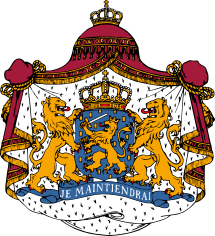
Helm Dutch royal crownEscutcheon Supporters Two lions rampant Or armed and langued GulesMotto JE MAINTIENDRAI
Mediaeval French: I will maintainOther elements Banner Upon her succesion to the throne, the Beatrix adopted the Royal Standard of the Netherlands, which is a square orange flag, divided in four quarters by a nassau-blue cross. All quarters show a white and blue bugle-horn, taken from the coat of arms of the Principality of Orange. In the centre of the flag is the (small) coat of arms of the Kingdom, which originates from the arms of the House of Nassau, surmounted by a royal crown and surrounded by the insignia of the Grand Cross of the Military William Order.
Symbolism The seven arrows stand for the Seven Provinces of the Union of Utrecht.Previous versions Prior to her accession to the throne, Beatrix as a princess bore the following arms: quarterly, 1 and 3, Azure, billetty Or a lion with a coronet Or armed and langued Gules holding in his dexter paw a sword Argent hilted Or and in the sinister paw seven arrows Argent pointed and bound together Or (royal arms of the Netherlands, i.e. that of his mother, Queen Juliana), 2 and 4, Or, a horn azure, langued gules (arms of the former Principality of Orange), on an inescutcheon argent, a rose gules, seeded vert (arms of the House of Lippe-Biesterfeld, i.e. that of his late father, Prince Bernhard).Issue
Name Birth Marriage Date Spouse Issue Prince Willem-Alexander 27 April 1967 2 February 2002 Máxima Zorreguieta Cerruti Princess Catharina-Amalia
Princess Alexia
Princess ArianePrince Friso 25 September 1968 24 April 2004 Mabel Wisse Smit Countess Luana
Countess ZariaPrince Constantijn 11 October 1969 19 May 2001 Laurentien Brinkhorst Countess Eloise
Count Claus-Casimir
Countess LeonoreAncestry
See also: Dutch monarchs family treeAncestors of Beatrix of the Netherlands 16. Julius, Count of Lippe-Biesterfeld 8. Ernest II, Count of Lippe-Biesterfeld 17. Countess Adelheid of Castell-Castell 4. Prince Bernhard of Lippe-Biesterfeld 18. Count Leopold of Wartensleben 9. Countess Caroline of Wartensleben 19. Mathilde Halbach 2. Prince Bernhard of Lippe-Biesterfeld 20. Adolf of Cramm 10. Baron Aschwin of Sierstorpff-Cramm 21. Hedwig of Cramm 5. Armgard of Sierstorpff-Cramm 22. Ernst, Count of Sierstorpff-Driburg 11. Baroness Hedwig of Sierstorpff-Driburg 23. Baroness Karoline von Vincke 1. Beatrix of the Netherlands 24. Paul Frederick, Grand Duke of Mecklenburg-Schwerin 12. Frederick Francis II, Grand Duke of Mecklenburg-Schwerin 25. Princess Alexandrine of Prussia 6. Duke Henry of Mecklenburg-Schwerin 26. Prince Adolph of Schwarzburg-Rudolstadt 13. Princess Marie of Schwarzburg-Rudolstadt 27. Princess Mathilde of Schonburg-Waldenburg 3. Juliana of the Netherlands 28. William II of the Netherlands 14. William III of the Netherlands 29. Grand Duchess Anna Pavlovna of Russia 7. Wilhelmina of the Netherlands 30. George Victor, Prince of Waldeck and Pyrmont 15. Princess Emma of Waldeck and Pyrmont 31. Princess Helena of Nassau Prime Ministers during the Queen's reign
Prime Ministers during the Queen's reign Polity Prime Minister Start year End year Aruba Henny Eman 1986 1989[22] Nelson O. Oduber 1989 1994 Henny Eman 1994 2001 Nelson O. Oduber 2001 2009 Mike Eman 2009 present Netherlands Dries van Agt 1977 1982 Ruud Lubbers 1982 1994 Wim Kok 1994 2002 Jan Peter Balkenende 2002 2010 Mark Rutte 2010 present Netherlands Antilles Dominico Martina 1979 1984 Maria Liberia Peters 1984 1986 Dominico Martina 1986 1988 Maria Liberia Peters 1988 1993 Susanne Camelia-Römer 1993 Alejandro Felippe Paula Miguel Arcangel Pourier 1994 1998 Susanne Camelia-Römer 1998 1999 Miguel Arcangel Pourier 1999 2002 Etienne Ys 2002 2003 Ben Komproe 2003 Mirna Louisa-Godett 2003 2004 Etienne Ys 2004 2006 Emily de Jongh-Elhage 2006 2010 Curaçao Gerrit Schotte 2010 present Sint Maarten Sarah Wescot-Williams 2010 present References
- ^ a b c d e Youth. The Dutch Royal House. Retrieved on 2008-07-11.
- ^ De vijf peetouders van prinses Beatrix. The Memory of the Netherlands. Retrieved on 2008-07-11.
- ^ "CBC News". Cbc.ca. 18 January 2008. http://www.cbc.ca/news/background/royalty/. Retrieved 2010-03-05.
- ^ Education. The Dutch Royal House. Retrieved on 2008-07-11.
- ^ "National Capital Commission". Canadascapital.gc.ca. http://www.canadascapital.gc.ca/bins/ncc_web_content_page.asp?cid=16297-16298-10118-10120&lang=1&bhcp=1. Retrieved 2010-03-05.
- ^ a b c "Het Koninklijk Huis". Koninklijkhuis.nl. http://www.koninklijkhuis.nl/Wie_is_wie/H_M_de_Koningin/Studie. Retrieved 2010-03-05.
- ^ "Bilderberg Meeting of 1997 Assembles". PR Newswire. 13 June 1997. http://www.prnewswire.de/cgi/release?id=42594.
- ^ [1][dead link]
- ^ The complete text of the speech can be found at http://www.koninklijkhuis.nl/NL/nieuws/nieuws.html?Toespraken/2223.html
- ^ The complete broadcast is available at http://cgi.omroep.nl/cgi-bin/streams?/nos/nieuws/2005/februari/video/080205/beatrix_toespraak.wmv
- ^ NOS. "Koninklijke familie was doelwit (Royal family was the target) (Dutch)". http://www.nos.nl/nosjournaal/artikelen/2009/4/30/300409_persconferentie.html. Retrieved 2009-05-01.
- ^ "Duth Royal House - Palaces and Immovable Property". Archived from the original on 22 June 2007. http://web.archive.org/web/20070622001117/http://www.koninklijkhuis.nl/english/content.jsp?objectid=13342. Retrieved 2008-06-29.
- ^ "Dutch Royal House - Movable Property". Archived from the original on 29 September 2007. http://web.archive.org/web/20070929135903/http://www.koninklijkhuis.nl/english/content.jsp?objectid=13343. Retrieved 2008-06-29.
- ^ "Dutch Royal House - Royal Archives". Archived from the original on 21 June 2008. http://web.archive.org/web/20080621112734/http://www.koninklijkhuis.nl/english/content.jsp?objectid=13380. Retrieved 2008-06-29.
- ^ "Royal House Finances Act 1972". http://www.st-ab.nl/wetten/0484_Wet_financieel_statuut_van_het_Koninklijk_Huis.htm.
- ^ "Cabinet opinion on Report on cost of Royal House". http://www.rijksoverheid.nl/documenten-en-publicaties/kamerstukken/2009/03/19/brief-aan-de-tweede-kamer-over-stuurgroep-zalm.html.
- ^ "Report on cost of Royal House". http://www.rijksoverheid.nl/documenten-en-publicaties/kamerstukken/2009/03/03/rapport-herziening-stelsel-kosten-koninklijk-huis.html.
- ^ "Budget for The King 2010". http://www.rijksbegroting.nl/2010/overzicht/begrotingsstaat,I-Huis-der-Koningin.html.
- ^ "In Pictures: The World's Richest Royals". Forbes.com. 30 August 2007. http://www.forbes.com/2007/08/30/worlds-richest-royals-biz-royals07-cx_lk_0830royalintro_slide_15.html?thisSpeed=30000. Retrieved 2010-03-05.
- ^ "The Dutch Royal House; FAQ; "How should I address members of the Royal House?"". Archived from the original on 10 June 2007. http://web.archive.org/web/20070610075751/http://www.koninklijkhuis.nl/english/content.jsp?objectid=13853. Retrieved 2008-06-29.
- ^ "Dutch Royal House - Coat of Arms and standard". Archived from the original on 21 June 2008. http://web.archive.org/web/20080621112631/http://www.koninklijkhuis.nl/english/content.jsp?objectid=13334. Retrieved 2008-06-29.
- ^ Aruba received status aparte in 1986.
External links
Beatrix of the NetherlandsCadet branch of the House of LippeBorn: 31 January 1938Regnal titles Preceded by
JulianaQueen of the Netherlands
30 April 1980–presentIncumbent
Heir:
Willem-Alexander, Prince of OrangeDutch royalty Preceded by
Princess Juliana
later became Queen JulianaHeir to the Dutch throne
as heiress presumptive
6 September 1948 – 30 April 1980Succeeded by
Willem-Alexander, Prince of OrangeBritish royalty Preceded by
Huberta DeuseLine of succession to the British throne Succeeded by
Princess Catharina-Amalia of the NetherlandsMonarchs of the Netherlands House of Orange-Nassau 1st Generation 2nd Generation 3rd Generation 4th Generation 5th Generation 6th Generation none7th Generation Heads of state of the European Union member states - Fischer (AT)
- Albert II (BE)
- Parvanov (BG)
- Christofias (CY)
- Klaus (CZ)
- Margrethe II (DK)
- Ilves (EE)
- Halonen (FI)
- Sarkozy (FR)
- Wulff (DE)
- Papoulias (GR)
- Schmitt (HU)
- Higgins (IE)
- Napolitano (IT)
- Bērziņš (LV)
- Grybauskaitė (LT)
- Henri (LU)
- Abela (MT)
- Beatrix (NL)
- Komorowski (PL)
- Cavaco Silva (PT)
- Băsescu (RO)
- Gašparovič (SK)
- Türk (SI)
- Juan Carlos I (ES)
- Carl XVI Gustaf (SE)
- Elizabeth II (UK)
Categories:- Dutch monarchs
- Queens regnant
- Reigning monarchs
- Current national leaders
- House of Orange-Nassau
- Protestant monarchs
- Heirs presumptive to the Dutch throne
- Congressional Gold Medal recipients
- Charlemagne Prize recipients
- Attempted assassination survivors
- Members of the Council of State of the Netherlands
- Leiden University alumni
- 1938 births
- Living people
- Honorary Dames Grand Cross of the Royal Victorian Order
- Knights of the Elephant
- Knights of the Golden Fleece
- Dames of the Order of the Rajamitrabhorn
- Grand Cordons of the Order of Leopold (Belgium)
- Knights Grand Cross with Collar of the Order of St. Olav
- Grand Crosses Special Class of the Order of Merit of the Federal Republic of Germany
- Grand Crosses of the Order of the Star of Romania
- Grand Collars of the Order of Prince Henry
- Extra Ladies of the Order of the Garter
- Grand Masters of the Military William Order
- Grand Masters of the Order of the Netherlands Lion
- Grand Masters of the Order of the Gold Lion of the House of Nassau
- Grand Masters of the Order of the House of Orange
- Grand Masters of the Order of Orange-Nassau
- Recipients of the Royal Victorian Chain
- Recipients of the Order of the Three Stars, 1st Class
- Recipients of the Order of the White Eagle (Poland)
- Recipients of the Collar of the Order of the Cross of Terra Mariana
- HRH The Prince of Orange *
Wikimedia Foundation. 2010.

